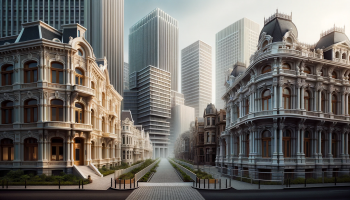jar546
CBO
Historic Preservation vs. Modern Codes: Navigating the Delicate Balance

We are back with another deep dive into the world of structures and codes. Today, we're tackling a topic that's both close to my heart and a real brain teaser: the delicate dance between historic preservation and today's building standards. Let's get into the nitty-gritty.

We are back with another deep dive into the world of structures and codes. Today, we're tackling a topic that's both close to my heart and a real brain teaser: the delicate dance between historic preservation and today's building standards. Let's get into the nitty-gritty.
The Charm of the Old
There's something undeniably captivating about old structures. They're a testament to the architectural prowess of bygone eras, giving us a glimpse into the past. Walking through a historic district, you can almost hear the echoes of history, from the clatter of horse-drawn carriages to the distant hum of jazz. These structures aren't just buildings; they're time capsules.The Imperative of the New
On the flip side, we have modern building codes. They're not just a bunch of rules scribbled in a handbook; they're the culmination of decades of research, innovation, and sometimes, hard lessons. These codes ensure safety, accessibility, and efficiency – they're the unsung heroes of our urban landscapes.The Tightrope Walk
So, how do we reconcile the two? It's like trying to fit a square peg in a round hole, right? Not necessarily. With a little creativity and a lot of respect for both the past and the present, it's possible to find a middle ground.- Adaptive Reuse: One of the most effective ways to preserve historic structures while meeting modern standards is through adaptive reuse. This involves repurposing old buildings for new functions while retaining their historic character. Think of an old warehouse turned chic loft apartments or a former schoolhouse transformed into a community center.
- Modern Interventions: Sometimes, it's not about changing the function but updating certain elements. This could mean retrofitting a historic building with modern HVAC systems, reinforcing walls, or integrating fire safety measures. The key is to do so subtly, ensuring the modern doesn't overshadow the historic.
- Collaboration is Key: Historic preservationists and building officials often come from different schools of thought, but collaboration can lead to incredible outcomes. By understanding each other's priorities and constraints, it's possible to develop solutions that honor the past while embracing the present.
